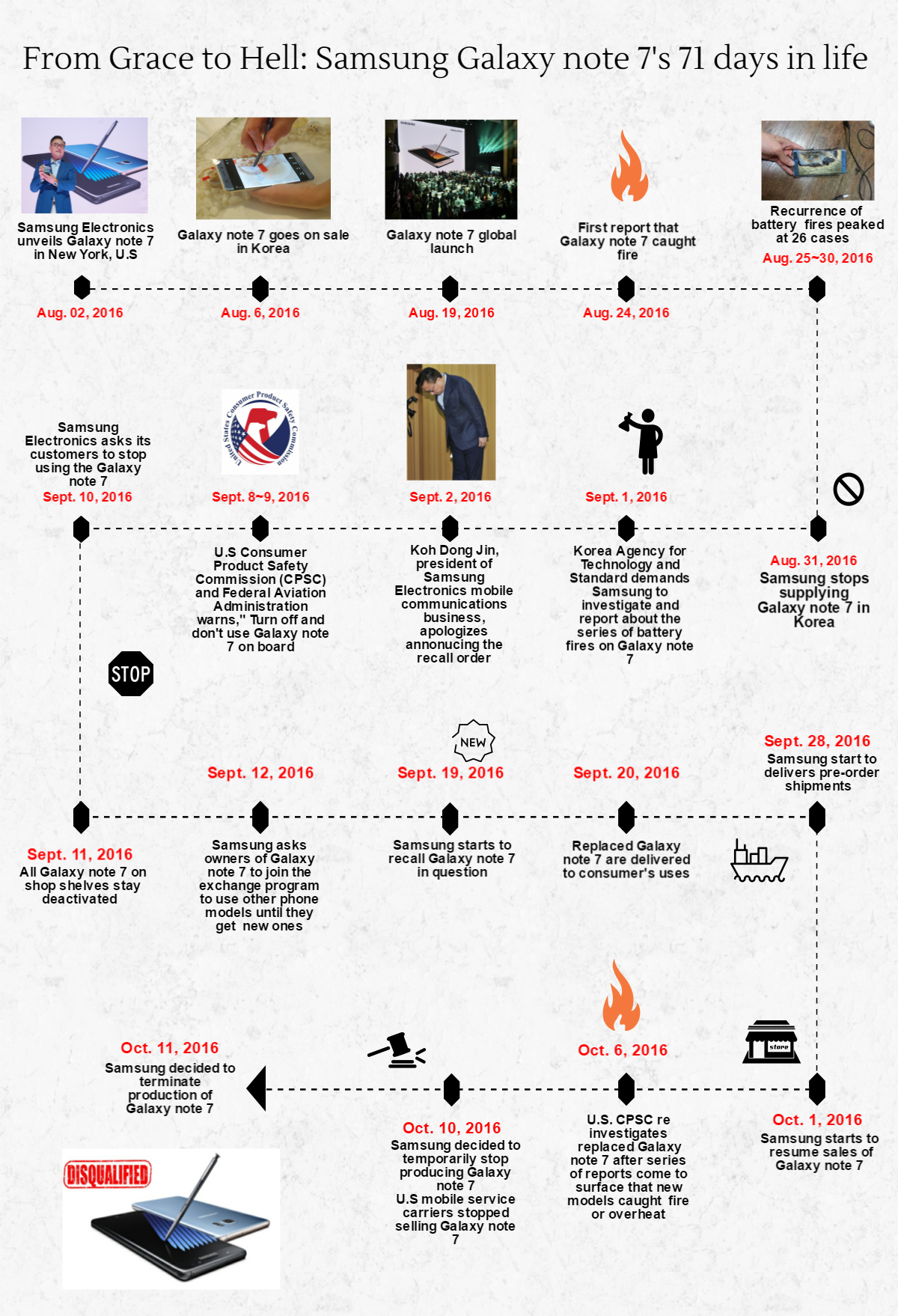The ill-fated smart phone model also became the shortest-lived and the most controversial one ever on record.

Kneeling down to a shower of consumer complaints and defamation, Samsung Electronics yesterday said that it would no longer produce and sell the Galaxy note 7, hammering the last nail on the coffin.
The filing with South Korean regulators read that the company would terminate production and sales of the Galaxy note 7, saying “Customers’ safety comes atop our priority level, so we have decided to halt sales and production.” The remarks were the last nail on the coffin for the troubled smart phone model
Repayment and replacements with other models will start from Oct. 13 through the last day of 2016 in Korea.
The production halt decision was in due course, given the seemingly unstoppable recurrence of battery fire or overheating incidents that occurred even after Samsung started to recall the first batch of Galaxy note 7 shipments, replacing the phones in question with new ones.

Yet, that’s just the first step in Samsung’s desperate efforts to exorcise the specter of battery fire scandal that otherwise will not only haunt the company’s ownership and management succession plan well into 2020, but also besiege its smart phone business. What will ensue in the aftermath of the decision is uncertain at least for now, but the damages will be so massive that they will be irreparable
The repercussions are already being felt palpable across the boards. Samsung’s production termination sent Korean stock market into chaos driving the benchmark KOSPI index plunging by. Share prices of Samsung Electronics were also in the whirlwind collapsing by 8%, the biggest daily drop in eight years, burning off US$17 billion out of its market value.
Yet, the chaos is just a prelude to what will be nightmarishly played out.

Following on the heel of the production halt, Samsung today revised its 3rd quarter financial results downward. Bucking the earlier estimate of 7.8 trillion won in the operating profit and 49 trillion won in revenues, Samsung estimated that it would chalk up an operating profit of 5.2 trillion won on revenue of 47 trillion won. Those matched analysts’ estimates that Samsung would lose about 3.3 trillion won in the lost sales alone of the Galaxy note 7. Yet, there are more at stake.
Consumers’ brand loyalty toward Samsung Galaxy is at the risk, endangering its decade-old and costly brand build-up campaign to establish itself as technology trailblazer. Heir apparent JY Lee’s management ability will be also questioned, dragging feet on its management succession plan
Samsung Electronics is scheduled to convene shareholders's meeting on Oct. 27 to put the agenda on the vote to appoint vice chairman and heir apparent JY Lee as an acting registered member of the board of director.
Pains are being felt down the road to its supply chain partners, risking break up Samsung’s well established smart phone manufacturing ecosystem.

More than 150 first-tier subcontractors have been supplying a wide array of parts and components from camera modules to metal cases to touch screen panel to NFC and wireless charging system to fingerprint recognition system.
Down the road, several hundreds of second-or third-tier parts and components vendors are underlying the supply chain system.
About 700 to 1,000 parts and components are used per piece to build smart phones.
So far, Samsung is known to have produced about 5 million units of Galaxy note 7 including the first batch of recalled 2.5 million units and the to-be –replaced 2.5 million units. Even If Samsung decided to dump all of them, no reports are available of how to redeem their supply chain partners’ supplies. They believe that although there was no precedent to refer to, Samsung will pay back them.
At issue is how to write off or recycle huge inventories in their warehouses or on the supply. Samsung usually asks their supply chain partners to have one month’s worth of inventories ready on hand to ensure just-in-time delivery. Keeping them unused for a while will severely squeeze their financial strength

True enough, they have been supplying Samsung on a shoe’s string, barely making money, as Samsung has been forcing down their prices pinching their profitability.
It is a well-known fact that Samsung’s healthy profitability comes at the expense of their supply chain partners’ profit.
The scarcity of financial resources will risk forcing them to spend less on R&D or technology innovations disqualifying their quality assurance programs and eventually discrediting Samsung’s supply chain system.
Consumer confidence in Samsung’s technology prowess is at risk, too, as they got disenchanted with Samsung’s engineering and system knowledge. Samsung is now trying to find what went wrong with the battery of Galaxy note 7, but failed to get the slimmest clue to what really caused the battery fire.
The ultra-thin battery separator of the Galaxy note 7 was mainly blamed for the fire or overheating, as it was too thin to keep in check the overflowing of Li-ions from cathode and anode electrode, but the question mark is about why its built-in battery management system didn't work to shut down or slow down the raid movements of ions. If the BM controllers was working properly , but didn't engage in the shutdown or slowdown, that indicates that nothing went wrong with the battery system suggesting that external forces short-circuit the battery system going unnoticed by the BM controllers


